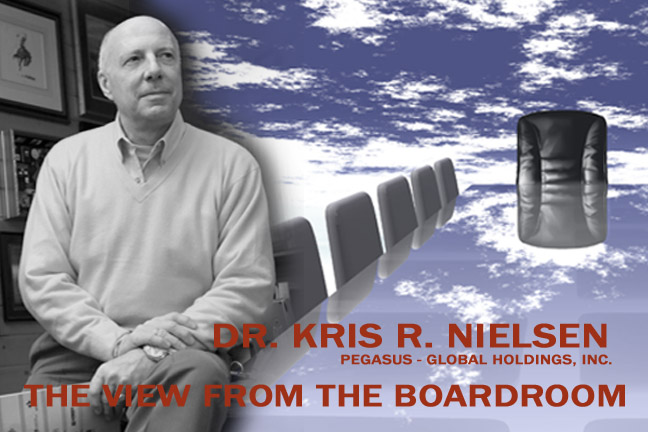My early mentor in the business world was Jim Taylor. Jim shaped a lot of my thinking on the world and internationalism, especially regarding business and the holistic relationship between seemingly unrelated events.
When I met Jim he just finished a decade (approximately the 1970’s) at the helm of Booz, Allen & Co. It was during his term that Booz expanded globally and became the first management consulting firm with revenues greater than $1 billion. Surprisingly, he agreed to serve on Neislen-Wurster's Board of Directors. I had founded Nielsen-Wurster, the parent company of Pegasus-Global in 1976, but by 1980 NW was still a small firm with a little over 97 percent of its business in the US.
Jim taught me that Boards should be partially made up of individuals who are aware of past patterns and trends and who were able to offer management insight into evolving patterns and trends.
In 1982, we had an assertive (some would say brash) young woman join the firm – Pat Galloway. She presented to the Board her vision that we should become an international niche management consulting firm and laid out a ten year plan to accomplish those objectives. One of the underlying reasons for diversifying was the economic ills in the US at the time. Frankly, the future of management consulting looked bleak at the time. When the Board heard her ideas, the reaction was mixed. Even Jim Taylor was against the idea at first. Fortunately, I was convinced by Pat’s arguments. Within four years she accomplished her goals and we never looked back. Jim Taylor later complimented her vision.
I am currently seeing a great deal of unimaginative thinking globally by Boards, the kind of resistance to change that Pat Galloway faced and succeeded in spite of. Because of the current world wide economic shock, many industry sectors continue to struggle.
This year will be telling for the Oil & Gas, Power Generation, and the public Infrastructure as well as the Engineering & Construction sectors. In the first two sectors (Oil & Gas and Power Generation) there has been a fundamental shift from the historic growth patterns in energy demand. Demand will be there for decades, but may have peaked (oil usage), will not grow as fast (power generation), and may have a different geographic locus (Asia and South America versus Europe and North America).
In the Public Infrastructure sector the knee jerk reaction of governments to economic downturn has sealed the fate of “stimulus spending” on infrastructure around the globe – the world economy cannot afford the huge debt that all of nations have accumulated in the last two years.
As public stimulus spending is winding down, it will not and should not be replaced with several years of normal, pre-crisis spending levels. For the Engineering & Construction sector, similar problems are emerging as a result of the lack of intelligent spending in the other three sectors.
Legacy (pre-mid 2008) project backlogs are rapidly disappearing because uncertainty about the global strength. Timing of the recovery is affecting investment decisions throughout the private and public sectors. At the current time it appears the E&C industry will not see increased interest from either public or private owners until the second half of 2011, at the earliest.
Now, why I am I telling you these facts? There are several seemingly unrelated events that leave me questioning whether Boards of Directors are able to provide management direction with the twin goals of being aware of past patterns and trends and using that understanding to provide insight into evolving patterns and trends. For instance:
•Last week Pat Galloway and I attended the annual conference of the Society for Social Management Systems (SSMS) in Kochi, Japan. Kochi is a typical medium sized city (population 1+ million) in Japan, 1 ½ hours by air from Tokyo, with no dominant international firm, but rather many firms that support the glamour names of industrial Japan. I have been going to Kochi for most of this decade. Unlike past years, the feeling of despair and resignation was evident everywhere. The people evidenced a sense that they merely treading water. Japan for most of this decade has sent the greater percentage of their exports to Asia rather than the US.
•The SSMS has as its goal the creation of a new quasi-profession that combines the thinking of the social sciences with the thinking of engineering to better serve societal needs. As Dr. A.K.W. Jayawardane, Dean of Engineering at the University of Moratuwa in Sri Lanka said, “Any action that is taken to improve the safety of people, property, infrastructure and health, welfare and standard of living of people can be considered as improving our social management systems.” Pat Galloway and I have been active in the society for the six years it has been in existence because it fosters creative thinking regarding problems of owners and private companies. Over the years many creative ideas have come forth from the SSMS. But, last week, it seemed that the same old themes were being presented among the representatives from 11 countries (10 from developed, developing and under developed Asian countries). Even conversations from professional friends in SSMS were surprising. Again, it was a repeat of merely treading water! No one had imagination.
•I have observed several boards in the last few months turning back to the “tried and true” business practices “that have always worked in the past.” All businesses suffered from shock in 2009, and managers are now turning from survival plans to future strategic plans. Take the advice that Booz & Co. (the old Booz, Allen & Co. and the same company that my old mentor headed), offered their clients when they wrote: “Each year Booz & Company’s industry teams write perspectives for their clients, reflecting on the previous year and considering what may come in the year ahead — and how to respond to it.”
Booz’s basic message was summarized as follows: “In addition to the long shadow cast by the economic crisis, this year’s industry outlooks also contain a collective note of warning that deserves even more attention: A handful of underlying structural changes — in demographics and consumer economics, globalization, and sustainability — are having a more irrevocable, dislocating effect on virtually every industry than the financial meltdown ever could. Worse yet, although most companies recognize that they must transform to survive and succeed in the future, they are ill equipped to do so. Many lack the capabilities they will need; most are not properly structured to respond to these changes as they unfold.” In regards to two of the industries, Oil & Gas and Chemical, they suggested looking “to the left side of the supply curve.”
It may be proper advice, but there is no imagination or vision in this solution.
Considering all these disparate thoughts, I fault management and the Boards they turn to for intelligent ambitious advice throughout North America, Asia, Europe, South America and Australia. Boards are being too conservative.
I suggest that the current crisis should be looked upon not as a downturn to be endured but an opportunity for revival and growth. Carlota Perez suggested in 2003 in her Technical Revolutions and Financial Capital: The Dynamics of Bubbles and Golden Ages that there is a cyclical period in all business sectors, The difference between the first half of the cycle and the second half of the cycle are some wrenching, traumatic events, such as those that have happened in the last two years, which cause industries and governments to wring their hands and do.....nothing.
Perez concludes that the “linchpins of the golden age will include the worldwide build-out of a new services-oriented infrastructure based on digital technology and a general shift to cleaner energy and environmentally safer technologies.”
This statement could be read to state that the future of the Oil & Gas and Chemical sectors will be bleak. Thus all our directors' and manager's “treading water.” But I would suggest that the future of both industries may be much different.
The Oil & Gas industry is a large source of carbon. Different usage concepts causing a shift to cleaner energy using environmentally safer technologies will mean that a greater amount of carbon is available. Carbon is one of the basic building blocks of today’s chemical industry. Seeking niches in which both industries can benefit from the creation and/or use of carbon is the type of thinking that would be useful to many firms in these two industries. Thus, the “golden age” will create a greater and greater need for carbon which coincides with societal demand that carbon production be reduced.
It is only through the stimulation and questioning of the thought processes behind strategic thinking that a new vision will emerge. From new visions, rather than old thinking, will emerge the ideas that fuel imagination. Unless people are given some purpose, they will continue to tread water and despair.
Subscribe to:
Post Comments (Atom)


No comments:
Post a Comment